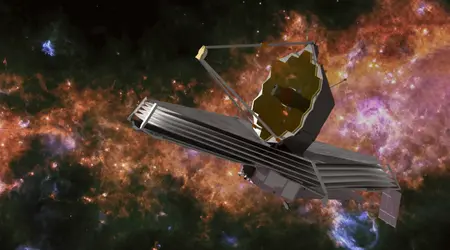James Webb Telescope: The Discoveries That Revolutionized Astronomy

The James Webb Telescope has reshaped our understanding of the universe, delivering groundbreaking discoveries that redefine astrophysics.
Anúncios
Since its deployment, Webb has provided unprecedented clarity in cosmic observations, unveiling the early universe, detecting exoplanets, and revealing galactic structures in exquisite detail.
This revolutionary instrument has exceeded expectations, offering new insights that were once beyond our reach.
Peering Into the Cosmic Dawn
One of Webb’s most profound contributions is its ability to observe the first galaxies formed after the Big Bang.
By capturing infrared light that has traveled for over 13 billion years, the telescope allows astronomers to study structures from the universe’s infancy.
Recent observations detected galaxies existing merely 300 million years post-Big Bang, challenging current models of galactic evolution.
This discovery suggests star formation in the early universe occurred faster than previously thought, raising new questions about cosmological theories.
The ability to observe such ancient structures has provided insights into the formation and evolution of galaxies.
By studying the spectral signatures of these early galaxies, astronomers can determine the elemental composition of the universe’s first celestial bodies.
This information is crucial for understanding how heavier elements, necessary for planet formation, emerged over time.
Additionally, these observations suggest that supermassive black holes may have played a more significant role in early galaxy formation than previously assumed.
The presence of such massive structures in young galaxies forces scientists to reevaluate existing models of galactic evolution and the interplay between black holes and their surrounding environments.
+ Dayson’s Star: What It Is and How It Influences Modern Astronomy
Webb’s ability to capture these ancient cosmic moments has provided a crucial link between theoretical predictions and observational data.
By confirming or challenging long-held beliefs about galaxy formation, Webb continues to refine our understanding of the universe’s first billion years.
The telescope’s deep-field images have uncovered star clusters previously unseen, revealing a more dynamic and active early universe than scientists had anticipated.
Beyond identifying early galaxies, Webb’s data contributes to the study of reionization, a pivotal phase when the first stars ionized the intergalactic medium.
This event transformed the universe from a dense, opaque environment into the vast, transparent cosmos we observe today.
Understanding this process helps astronomers comprehend the large-scale evolution of cosmic structures.
The Atmospheres of Distant Worlds
Webb’s infrared capabilities have also revolutionized exoplanet studies.
By analyzing starlight passing through planetary atmospheres, it has identified chemical compositions with remarkable precision.
A breakthrough came with the detection of carbon dioxide in the atmosphere of WASP-39b, marking the first definitive CO2 detection in an exoplanet outside our solar system (NASA, 2022).
This milestone paves the way for assessing habitability in distant worlds, fueling the search for extraterrestrial life.
Further observations have revealed the presence of water vapor, methane, and even potential biosignatures in exoplanetary atmospheres.
The ability to differentiate these molecules allows scientists to categorize exoplanets into various types, from gas giants to potentially habitable rocky worlds.
As Webb continues its survey, the list of known exoplanets with detailed atmospheric compositions will grow, refining our understanding of planetary formation and evolution.
The impact of these discoveries extends beyond astrophysics; they influence astrobiology and the search for life beyond Earth.
By identifying habitable conditions and key chemical signatures, Webb provides essential data for future missions that could directly search for biological activity on distant exoplanets.
Webb’s observations have also deepened our understanding of atmospheric dynamics on alien worlds.
By detecting seasonal variations, high-altitude clouds, and unexpected temperature shifts, scientists can piece together more complete models of exoplanetary weather systems.
This level of detail is crucial for determining which exoplanets have stable climates that could support life.
As Webb continues to analyze the chemical fingerprints of these worlds, its findings inform future exploration missions.
Whether through upcoming space probes or advanced Earth-based observatories, Webb’s catalog of exoplanet atmospheres lays the groundwork for the next stage of interstellar discovery.
| Exoplanet | Detected Molecules | Potential for Habitability |
|---|---|---|
| WASP-39b | CO2, H2O, Na, K | No |
| TRAPPIST-1e | H2O (possible) | High |
| K2-18b | Methane, CO2 | Moderate |

Black Holes and Galactic Evolution
Beyond exoplanets, the James Webb Telescope has provided astonishing insights into supermassive black holes and galaxy formation.
By peering into the dense heart of ancient galaxies, the James Webb Telescope has identified unexpectedly massive black holes in early cosmic history.
These findings suggest black hole growth occurred much earlier than models predicted, influencing the formation of surrounding galaxies in unforeseen ways.
Observing black holes at these early stages of the universe has led to unexpected discoveries regarding their feeding mechanisms.
Researchers previously believed that such rapid black hole growth would require a continuous influx of gas and matter, but Webb’s data suggest alternative explanations.
These findings raise new theoretical questions about the interplay between black holes and their host galaxies.
Moreover, Webb’s observations have implications for dark matter studies.
By analyzing the gravitational effects of these black holes on surrounding matter, scientists can better understand the role of dark matter in early cosmic structures.
This research could ultimately lead to breakthroughs in one of astronomy’s most perplexing mysteries: the nature of dark matter and its influence on cosmic evolution.
Webb has also revealed that some of the universe’s first galaxies formed around actively feeding black holes.
The discovery of these luminous quasars suggests a complex relationship between star formation and black hole activity, shedding new light on how galaxies co-evolved with their central supermassive black holes.
These findings help astronomers refine simulations of cosmic history, ensuring that future theoretical models more accurately reflect the real universe.
By bridging the gap between early black hole growth and present-day galaxy structures, Webb has provided an essential missing piece in the puzzle of cosmic evolution.
++ Nuclear Propulsion: A Game-Changer for Deep Space Missions
Star Formation in Unprecedented Detail
Webb’s high-resolution imaging has pierced through dense cosmic dust, exposing previously hidden stellar nurseries.
It captured the iconic Pillars of Creation with an unparalleled level of detail, revealing intricate star-forming processes.
This level of clarity enables researchers to refine theories on stellar evolution, shedding light on the forces shaping galaxies over billions of years.
The ability to see inside stellar nurseries allows astronomers to study protostars at different stages of development.
By analyzing these young stars, scientists can determine how planetary systems emerge and evolve.
This information is particularly useful in comparing star formation across different regions of the universe.
Webb’s contributions also extend to studying supernova remnants and the recycling of cosmic material.
When massive stars explode, they distribute heavy elements throughout space, contributing to future star and planet formation.
By examining these remnants in detail, the James Webb Telescope helps piece together the intricate cycle of cosmic evolution.
Webb’s infrared vision allows scientists to track how interstellar dust clouds collapse into new stars, offering never-before-seen details on how planetary systems take shape.
These observations provide crucial data on the raw materials available for planet formation in different stellar environments.
By capturing the light of young stellar objects at various life stages, Webb delivers a dynamic timeline of star birth.
These revelations contribute to a deeper understanding of how the conditions in star-forming regions influence the composition and potential habitability of the planets they produce.
| Discovery | Implication |
|---|---|
| Early massive black holes | Faster galactic evolution |
| CO2 detection in exoplanets | Refined habitability models |
| Infrared view of protostars | Better understanding of star birth |
A New Era of Astronomy
The James Webb Telescope is not just a successor to Hubble; it is a paradigm shift in our cosmic exploration.
Its discoveries challenge long-standing theories and open new scientific frontiers.
As Webb continues scanning the universe, astronomers anticipate more transformative insights, further expanding our comprehension of space and time.
With each observation, Webb redefines the boundaries of human knowledge, proving that the universe still holds countless secrets waiting to be uncovered.
The ongoing discoveries will likely influence future space missions, guiding next-generation telescopes in their search for answers to fundamental questions about our existence.
As the telescope continues its mission, the implications for technology, physics, and philosophy will only grow.
Humanity stands on the brink of a new cosmic age, driven by Webb’s unprecedented ability to unravel the deepest mysteries of the cosmos.
